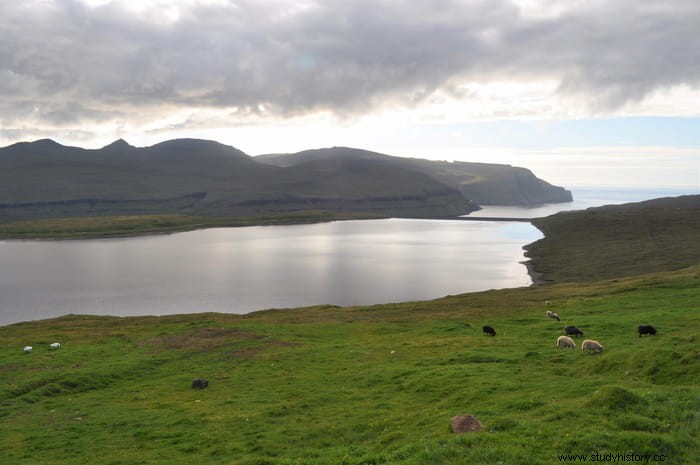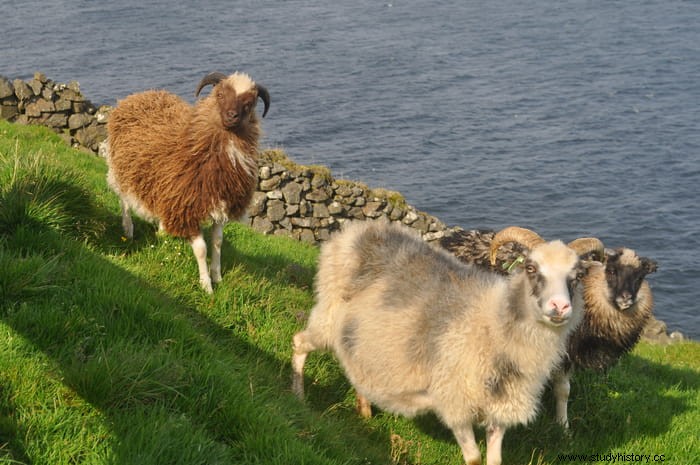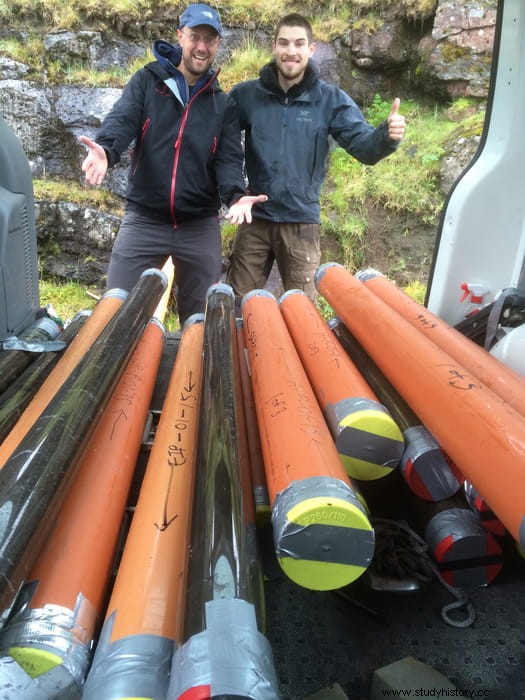New evidence from a lake bottom in the remote Faroe Islands in the North Atlantic indicates that an unknown group of humans settled there around AD 500, some 350 years before the Vikings, who until recently were considered the first human inhabitants. The settlers may have been Celts who crossed rough and uncharted seas from what is now Scotland or Ireland. The findings are published in the journal Communications Earth &Environment.
The Faroe Islands are a small, rugged archipelago located halfway between Norway and Iceland, about 200 miles northwest of Scotland. Its coasts are dominated by imposing cliffs; lashed by strong winds and cloudy weather, the rocky landscape is mostly tundra. There is no evidence that indigenous people have lived there, making it one of the few lands on the planet that remained uninhabited until historical times. Past archaeological excavations indicate that the Vikings first arrived around 850 AD, shortly after they developed the technology of long-distance navigation. The settlement may have been a springboard for the Viking colonization of Iceland in 874, and their short-lived colonization of Greenland around 980.
The new study, led by scientists at Columbia University's Lamont-Doherty Earth Observatory, is based on lake sediments that contain hints that domestic sheep suddenly appeared around the year 500, long before Norse occupation. Previously, the islands were not home to any mammals, domestic or otherwise; the sheep could only arrive with the people. The study isn't the first to propose that someone got there first, but the researchers say this confirms the case.

In the 1980s, researchers determined that plantago lanceolata , a grass commonly associated with disturbed areas and pastures, and often used as an indicator of early human presence in Europe, appeared in the Faroe Islands around 2200 BC. At the time, this was considered possible evidence of human arrival. However, the seeds could have arrived with the wind, and the plant does not need human presence to establish itself. Similarly, studies of pollen taken from lake beds and bogs show that, sometime before the Norse period, woody vegetation largely disappeared, possibly due to persistent chewing by sheep, but also to natural climate changes.
Some medieval texts suggest that Irish monks arrived on the islands around the year 500. For example, Saint Brandan, a famous early Irish traveler, is said to have crossed the Atlantic with his companions between 512 and 530, and supposedly found a paradisiac island. Later speculations and maps say that it was the Faroe Islands -or the Azores, further south, or the Canary Islands- or that Brandán reached North America. There is no proof of any of this. Centuries later, in the year 825, the Irish monk and geographer Dicuil wrote that he had learned that hermits had been living on some unidentified northern islands for at least 100 years. Once again, subsequent speculation turned to the Faroe Islands, but there was never any proof.
The first physical evidence of early occupation came with a 2013 study in the journal Quaternary Science Reviews , which documented two burnt peat patches containing charred barley grains found under the floor of a Viking longhouse on the Faroese island of Sandoy. The researchers dated the grains to between 300 and 500 years before the Norse; barley was not found on the island before, so someone must have brought it. For many archaeologists, this constituted strong evidence of the existence of a population before the Vikings. However, others wanted to see some kind of corroboration before declaring the case closed.

The researchers in the new study used a non-archaeological approach. In a small boat, they sailed across a lake near the village of Eiði, the site of an ancient Viking town on the island of Eysturoy. At this location, open weighted tubes were dropped to the bottom to collect the mud sediments that fell year after year and accumulated over millennia, forming a long-term environmental record. The cores penetrated about 2.5 meters, recording some 10,000 years of environmental history. Scientists hoped to better understand the climate of the time of the Viking occupation, but they were in for a surprise.
From 51 centimeters deep in the sediments, they found indications of the sudden arrival of large numbers of sheep, most likely sometime between 492 and 512, but possibly as early as 370. The telltale signs:identifiable fragments of sheep DNA and two distinctive types of lipids produced in the digestive systems of sheep, called faecal biomarkers. The researchers also found human DNA fragments in the same layers, but suspect modern contamination during sample handling. A layer of ash deposited in a well-known eruption of an Icelandic volcano in AD 877 helped them reliably date the underlying sediment sequences.
We see this as irrefutable proof that people were already there before the Vikings said lead author Lorelei Curtin. She pointed out that although the Faroes seem rugged and wild today, virtually every square inch of vegetation has been chewed up by Faroese sheep, a staple of the Faroese diet found almost everywhere. 
Aside from the earlier discovery of barley grains, no physical remains of earlier people have yet been found on the Faroe Islands, but the researchers say this is not surprising. In the Faroe Islands there are very few places suitable for settlement, mainly flat areas at the head of sheltered bays where the Norse would have built on earlier dwellings. On the other hand, sheep DNA and biomarkers start with a bang. It's like an on/off switch said Lamont-Doherty paleoclimatologist William D'Andrea, who co-led the study. He points out that the markers correspond well with the accounts of the Irish monks. But, he said he, those early writings are tenuous:it's all circumstantial .
So who were these early settlers? D'Andrea and Curtin speculate that they may have been Celts, though not necessarily monks. For one thing, many Faroese place names derive from Celtic words, and ancient, though undated, Celtic grave marks dot the islands. Furthermore, DNA studies of modern Faroese show that their paternal lineages are primarily Scandinavian, while their maternal lineages are primarily Celtic. Other regions of the North Atlantic show this asymmetry - Viking settlers are thought to have brought Celtic women with them - but the Faroe Islands have the highest level of maternal Celtic ancestry, suggesting a pre-Viking Celtic population. /P>
Kevin Edwards, an archaeologist and environmental researcher at the University of Aberdeen, and co-author of the 2013 barley grains paper, said the new study has produced compelling and exciting evidence for another island within the archipelago> from a previous human occupation. He added:Will similar evidence be found in Iceland, where similar arguments are made for a pre-Norse presence, and for which tantalizingly similar archaeological, pollen analytical and human DNA evidence is being presented?
